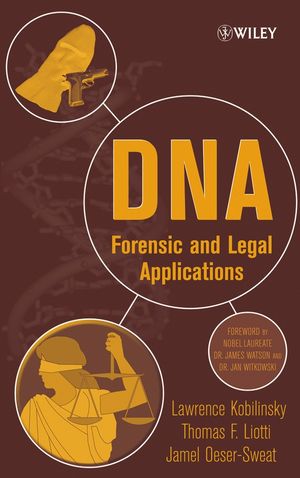DNA: Forensic and Legal ApplicationsISBN: 978-0-471-41478-0
Hardcover
392 pages
October 2004
 This is a Print-on-Demand title. It will be printed specifically to fill your order. Please allow an additional 10-15 days delivery time. The book is not returnable.
|
||||||
Preface.
Acknowledgements.
1. Biochemistry, Genetics, and Replication of DNA.
1.1 Evolution of Identification: From Faces to Fingerprints to DNA.
1.2 DNA and Heredity.
1.2.1 A Look at DNA from the Outside In.
1.2.2 DNA—The Chemistry.
1.2.3 Unique Sequence and Repetitious DNA.
1.3 DNA Replication.
1.3.1 Replication in the Cell.
1.3.2 Cloning (Gene Amplification).
2. Biological Evidence—Science and Criminal Investigation.
2.1 Crime Scene Investigation—Biological Evidence.
2.1.1 Help the Victim.
2.1.2 Protect the Scene.
2.1.3 Document the Scene.
2.1.4 Search the Scene.
2.1.5 Schematic Drawing Showing Location and Photography of Items of Evidence.
2.1.6 Packaging and Preserving Evidence.
2.1.7 Transport to Laboratory.
2.1.8 Sexual Assault Evidence.
2.1.9 Evidence Handling in the Laboratory.
2.1.10 Report Writing.
2.2 Serology.
2.2.1 Blood.
2.2.2 Semen.
2.2.3 Saliva.
2.2.4 Urine.
2.2.5 Hair.
2.3 Chain of Custody.
3. Forensic DNA Analysis Methods.
3.1 Associative Evidence and Polymorphism.
3.2 Restriction Fragment-Length Polymorphism.
3.2.1 Isolation of DNA.
3.2.2 Quantification.
3.2.3 Restriction Enzymes: DNA Scissors.
3.2.4 Gel Electrophoresis.
3.2.5 Southern Blotting.
3.2.6 Hybridization.
3.2.7 Autoradiography and Visualization of DNA Banding Pattern.
3.2.8 Analysis of RFLP Results.
3.2.9 Probe Stripping from Membrane.
3.2.10 Match Criteria.
3.2.11 Statistics and the Product Rule.
3.3 Polymerase Chain Reaction.
3.3.1 Development and Theory.
3.3.2 Isolation of DNA.
3.3.3 Quantification
3.3.4 Techniques.
3.4 Analysis of Y-Chromosome STRS.
3.4.1 Y-Chromosome Single-Nucleotide Polymorphism Analysis.
3.5 Analysis of Mitochondrial DNA.
3.5.1 The Mitochondrial Genome.
3.5.2 Quantification.
3.5.3 Sequencing.
3.5.4 Interpretation of Sequence Data.
3.5.5 Heteroplasmy.
3.5.6 Statistics.
3.5.7 SNP Analysis of Mitochondrial DNA.
3.6 Problems with PCR.
3.6.1 Contamination.
3.6.2 Degradation.
3.6.3 Sunlight.
3.6.4 Inhibitors.
3.6.5 Allelic Dropout—Null Alleles.
3.6.6 Human Error.
3.7 Underlying Facts and Assumptions in Forensic DNA Testing.
4. Genetics, Statistics, and Databases.
4.1 Human Genetics, Population Genetics, and Statistics.
4.1.1 Power of Forensic DNA Analysis: How Significant Is the Match?
4.1.2 Genetics and Statistics.
4.1.3 Mendel’s Laws of Genetics.
4.1.4 Meiosis.
4.2 Population Genetics.
4.2.1 Hardy–Weinberg Equilibrium.
4.2.2 Subpopulations and Substructure.
4.3 Need for Quality Control and Quality Assurance.
4.4 SWGDAM (Formerly Known as TWGDAM) Standards.
4.5 DNA Advisory Board.
4.6 Mitochondrial DNA and Y-Chromosome STR Analysis and Statistical Calculations.
4.7 Experimental Controls.
4.8 Validation of New DNA Methods.
4.9 Single-Nucleotide Polymorphism Analysis.
4.10 Database Size and Composition.
4.11 DNA Databases.
4.12 Power of Discrimination.
4.13 Mixtures and Statistics.
4.14 Probability of Exclusion.
4.15 Likelihood Ratio (LR).
4.16 Paternity Determinations.
4.16.1 Exclusion of the Alleged Father as the Biological Father.
4.16.2 Inclusion of the Alleged Father as the Biological Father.
4.17 Lab Accreditation, Certification, Reputation, and Facilities.
4.17.1 Quality Control.
4.17.2 Quality Assurance.
4.17.3 Proficiency Testing.
4.17.4 Certification.
4.17.5 Laboratory Accreditation.
4.18 Reviewing a DNA Report—A Sample RFLP Analysis.
4.19 Reviewing a DNA Report—A PCR-Based DNA Examination (HLADQA1, PM, D1S80, and CTT-CSF1PO, TPOX, THO1).
4.20 Reviewing a DNA Report—A PCR-STR-Based DNA Examination (CODIS Loci).
4.21 Reviewing a Paternity Report Based on Analysis of DNA.
5. Litigating a DNA Case.
5.1 Legal Theory.
5.1.1 Admissibility of Scientific Evidence: A Primer.
5.1.2 Common Law and The Creation of a Judicial Gatekeeping Function.
5.1.3 Federal Rules of Evidence and the Expansion of the Judicial Gatekeeping Function.
5.1.4 Daubert: The Supreme Court Sets Forth a Standard.
5.1.5 General Electric Company et al. v. Joiner et ux.
5.1.6 Kumho Tire: The Court Continues Its Expansion of the Judicial Gatekeeping Function.
5.1.7 Judicial Gatekeeping Function and Its Evolution in New York State.
5.2 Admissibility of DNA Evidence.
5.2.1 PCR-STR DNA Evidence.
5.2.2 Mitochondrial DNA.
5.2.3 Animal DNA.
5.2.4 Plant and Viral DNA.
5.2.5 Statistics.
5.2.6 Paternity.
5.3 Legal Practice.
5.3.1 Different Stages of a Trial.
5.4 DNA for Defense Attorneys—Contesting DNA Evidence.
5.5 DNA for Prosecutors.
5.6 DNA for Judges.
6. DNA Evidence at Trial.
6.1 Attacking and Defending DNA Evidence.
6.1.1 Theory of the Case/Plan of Attack.
6.1.2 What is Required for DNA Test Results to be Admitted into Evidence?
6.2 DNA for the Prosecutor or Those Who Seek to Admit DNA Evidence.
6.2.1 Effective Admission of DNA Evidence Takes Place in Three Stages.
6.3 DNA for the Defense or Those Who Seek to Mitigate the Effect of DNA Evidence.
6.3.1 Preventing the Admission of DNA Evidence in Part or in Its Entirety.
7. Exonerating the Innocent through DNA.
7.1 Postconviction Appeals Based upon DNA Evidence.
7.2 Postconviction DNA Testing: Recommendations for Handling Requests.
7.2.1 Role and Response of the Prosecutor.
7.2.2 Role and Response of the Defense Attorney.
7.3 Legal Standards Governing Postconviction Testing.
7.3.1 Argument for a Constitutional Right to Postconviction DNA Testing.
7.3.2 Other Non-Postconviction Testing Statute Arguments.
7.4 Postconviction DNA Testing Statutes.
7.5 Preventing Postconviction DNA Testing through Waiver.
7.6 The Future of DNA Technology.
Appendix A: Bibliography: Selected by Topic Area.
Appendix B: Cases Involving the Admissibility of DNA Evidence.
Appendix C: Information Pertinent to Attempts to Overturn Convictions Based Upon DNA Evidence.
Appendix D: Offenses in New York State Resulting in Mandatory DNA Testing for Database Inclusion.
Appendix E: Postconviction DNA Testing, Preservation of Evidence and Compensation for Wrongful Convictions: Relevant Legislative Information.
Appendix F: Items Obtained through Discovery.
Appendix G: Glossary.
Index.



